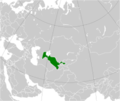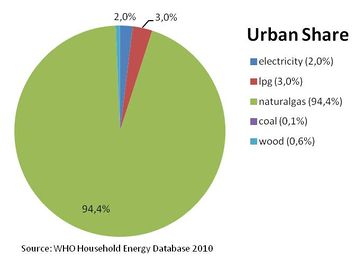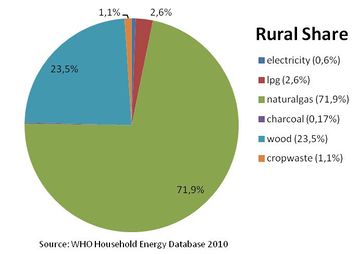Knowledge fuels change
For over a decade, Energypedia has shared free, reliable energy expertise with the world.
We’re now facing a serious funding gap.
Help keep this platform alive — your donation, big or small, truly matters!
Thank you for your support
Difference between revisions of "Uzbekistan Energy Situation"
***** (***** | *****) |
***** (***** | *****) m |
||
| (19 intermediate revisions by 5 users not shown) | |||
| Line 1: | Line 1: | ||
| − | { | + | {{CES Country |
| − | + | |CES Country Name=Uzbekistan | |
| − | | | + | |CES Country Capital=Tashkent |
| − | | | + | |CES Country Region Europe and Central Asia = Europe & Central Asia |
| − | | & | + | |CES Country Coordinates=41.0000° N, 69.0000° E |
| − | | | + | }} |
| − | |||
| − | |||
| − | |||
| − | |||
| − | |||
| − | + | = Introduction = | |
| − | |||
| − | |||
| − | + | Uzbekistan is located in the heart of Central Asia. The physical environment is diverse with flat desert covering 80% of the country and mountains in the east reaching over 4,500m high. Shrubland and savannah comprise 47% of the territory and 27% is comprised of cropland. It's climate is mainly continental with the average low temperature being 8.3°C and the average high temperature being 21.0°C <ref>CIA - The World Factbook</ref> Uzbekistan natural resources include natural gas, petroleum, and coal. Roughly 8.0% of Uzbekistan's land is covered by forest. The annual deforestation rate (between 2005-2010) was 0.12% <ref>FAO (2011): The State of the World's Forest</ref> | |
| − | |||
| − | + | <br/> | |
| − | |||
| − | |||
| − | + | Uzbekistan is Central Asias most populous country with a population of 28 million inhabitants. 63% of the population lives in rural areas and 37% in cities. The GDP in 2010 was 39 billion US$ and and GDP growth over recent years remained at high levels of 7 to 9%. GDP per capita in 2010 was 1,400 US$. National income sources comprise of the following shares: agriculture (44%), industry (20%), and services: (36%) <ref>CIA - The World Factbook</ref> Uzbekistan's literacy rate is 99%. However, poverty is prevalent as 45% of the population lives on less than 1.25 USD per day. | |
| − | |||
| − | | | + | [[Uzbekistan Energy Situation#toc|►Go to Top]] |
| − | |||
| − | |||
| − | + | = Energy Situation = | |
| − | |||
| − | + | Uzbekistan is one of the few countries which are fully self-sufficient in energy resources. It is the second largest of the Caspian gas producers (after Turkmenistan) and its abundant natural gas resources are used both for domestic consumption and export. <ref>IEA (2009): World Energy Outlook.</ref><br/>Oil and natural gas comprise 97% of the country's energy balance. Primary energy shares consist of 86.3% gas, 1.9% hydro, 2.5% coal and peet, and 9.3% crude oil. | |
| − | |||
| − | |||
| − | + | Uzbekistan is the largest electricity producer in Central Asia. Total national electricity capacity is 12.6 GW (as of 2007), of which 88.5% is provided by thermal power plants and 11.5% by hydropower plants. The price of electricity runs at 3.5 US Cent/kWh. | |
| − | |||
| − | + | The national electrification rate is 94.4%, but electrical supply to rural areas is unreliable and of low quality. There are often power blackouts that last many hours per day. Renovating the power transmission networks is one of the energy sectors priorities. | |
| − | |||
| − | |||
| − | + | A National Energy Efficiency Strategy has been in place since 2001. Besides international initiatives, a campaign has been carried out to install meters for consumers of natural gas and hot water. As a result, energy intensity of GDP decreased by 10%, from 0.96 kgoe/$ in 2000 to 0.86 kgoe/$ in 2004, still considerably high levels. There is also an Energy Efficiency Programme for the period to 2010, targeting 50% energy savings in the household and utility sectors. | |
| − | |||
| − | | | + | [[Uzbekistan Energy Situation#toc|►Go to Top]] |
| − | |||
| − | |||
| − | + | == Household Energy Situation == | |
| − | |||
| − | + | Percentage of energy types used for cooking in urban and rural areas | |
| − | |||
| − | |||
| − | + | <br/> | |
| − | |||
| − | | | + | [[File:Uzbekistan Urban Share.jpg|354px|Uzbekistan Urban Share.jpg|alt=Uzbekistan Urban Share.jpg]][[File:Uzbekistan Rural Share.jpg|358px|Uzbekistan Rural Share.jpg|alt=Uzbekistan Rural Share.jpg]] |
| − | | | ||
| − | Urban | ||
| − | + | <br/> | |
| − | + | <div class="draft">The percentage of the population using solid fuels (charcoal, coal, cropwaste, dung and wood) as cooking energy:</div><div class="draft">National: 11.6%, Urban: 5.5%, Rural: 25.2% | |
| + | <br/> | ||
| − | + | <u>'''Impact of use of solid fuel on health'''</u> | |
| − | + | </div> | |
| − | + | • Total annual deaths attributable to solid fuel use: 5300 persons<br/>• Percentage of national burden of diseases attributable to solid fuel use: 3.7%<br/><br/> | |
| − | | | + | [[Uzbekistan Energy Situation#toc|►Go to Top]] |
| − | |||
| − | + | == Potential for Renewables == | |
| − | |||
| − | |||
| − | + | Due to its abundance of energy, the development of renewable energy is not a high priority for the Government of Uzbekistan, except hydro power. Uzbekistan has 18 large hydroelectric stations. | |
| − | |||
| − | + | High start-up costs, low gas and electricity prices, and the lack of renewable energy promoting policies are reasons for the limited use of renewable energy sources. Nonetheless, a law “On Renewable Energy Sources” has been drafted. The national strategy on the development of RES is being formulated with the assistance of UNDP. | |
| − | |||
| − | |||
| − | | | + | Uzbekistan's climate conditions favor [[Portal:Solar|solar energy]]. There are 250 sunny days per year and the technically feasible potential of solar energy is 177 million toe (2 million GWh), which is much more than the national annual consumption. However, this potential energy source remains largely untapped due to high start-up costs. |
| − | |||
| − | | | + | Uzbekistan also has a high potential for [[Basics_on_Biomass|biomass energy generation]] as it is the fourth largest producer of cotton in the world. However, fuel wood is not a prospective option for energy production because Uzbekistan has very little forest coverage. |
| − | |||
| − | |||
| − | + | Significantly, Uzbekistan has initiated 79 CDM project proposals of which 59 have already been approved. | |
| − | |||
| − | | | + | [[Uzbekistan Energy Situation#toc|►Go to Top]] |
| − | |||
| − | |||
| − | + | = Further Information = | |
| − | |||
| − | + | *[[Portal:Countries|Country Portal on Energypedia]] | |
| − | + | = References = | |
| − | |||
| − | |||
| − | | | + | <references /> |
| − | + | [[Uzbekistan Energy Situation#toc|►Go to Top]] | |
| − | |||
| − | |||
| − | |||
| − | |||
| − | |||
| − | |||
| − | |||
| − | |||
| − | |||
| − | |||
| − | |||
| − | |||
| − | |||
| − | |||
| − | |||
| − | |||
| − | |||
| − | |||
| − | |||
| − | |||
| − | |||
| − | |||
| − | |||
| − | |||
| − | |||
| − | |||
| − | |||
| − | |||
| − | |||
| − | |||
| − | |||
| − | |||
| − | |||
| − | |||
| − | |||
| − | |||
| − | |||
| − | |||
| − | |||
| − | |||
| − | |||
| − | |||
| − | |||
| − | |||
| − | |||
| − | |||
| − | |||
| − | |||
| − | |||
| − | |||
| − | |||
| − | |||
| − | |||
| − | |||
| − | |||
| − | |||
| − | |||
| − | |||
| − | |||
| − | |||
| − | |||
| − | |||
| − | |||
| − | |||
| − | |||
| − | |||
| − | |||
| − | |||
| − | |||
| − | |||
| − | |||
| − | |||
| − | |||
| − | |||
| − | |||
| − | |||
| − | |||
| − | |||
| − | |||
| − | |||
| − | |||
| − | |||
| − | |||
| − | |||
| − | |||
| − | |||
| − | |||
| − | |||
| − | |||
| − | |||
| − | |||
| − | |||
| − | |||
| − | |||
| − | |||
| − | |||
| − | |||
[[Category:Uzbekistan]] | [[Category:Uzbekistan]] | ||
| + | [[Category:Europe_and_Central_Asia]] | ||
Latest revision as of 21:28, 10 July 2018
Capital:
Tashkent
Region:
Coordinates:
41.0000° N, 69.0000° E
Total Area (km²): It includes a country's total area, including areas under inland bodies of water and some coastal waterways.
XML error: Mismatched tag at line 6.
Population: It is based on the de facto definition of population, which counts all residents regardless of legal status or citizenship--except for refugees not permanently settled in the country of asylum, who are generally considered part of the population of their country of origin.
XML error: Mismatched tag at line 6. ()
Rural Population (% of total population): It refers to people living in rural areas as defined by national statistical offices. It is calculated as the difference between total population and urban population.
XML error: Mismatched tag at line 6. ()
GDP (current US$): It is the sum of gross value added by all resident producers in the economy plus any product taxes and minus any subsidies not included in the value of the products. It is calculated without making deductions for depreciation of fabricated assets or for depletion and degradation of natural resources.
XML error: Mismatched tag at line 6.2 ()
GDP Per Capita (current US$): It is gross domestic product divided by midyear population
XML error: Mismatched tag at line 6. ()
Access to Electricity (% of population): It is the percentage of population with access to electricity.
XML error: Mismatched tag at line 6.no data
Energy Imports Net (% of energy use): It is estimated as energy use less production, both measured in oil equivalents. A negative value indicates that the country is a net exporter. Energy use refers to use of primary energy before transformation to other end-use fuels, which is equal to indigenous production plus imports and stock changes, minus exports and fuels supplied to ships and aircraft engaged in international transport.
XML error: Mismatched tag at line 6.no data
Fossil Fuel Energy Consumption (% of total): It comprises coal, oil, petroleum, and natural gas products.
XML error: Mismatched tag at line 6.no data
Introduction
Uzbekistan is located in the heart of Central Asia. The physical environment is diverse with flat desert covering 80% of the country and mountains in the east reaching over 4,500m high. Shrubland and savannah comprise 47% of the territory and 27% is comprised of cropland. It's climate is mainly continental with the average low temperature being 8.3°C and the average high temperature being 21.0°C [1] Uzbekistan natural resources include natural gas, petroleum, and coal. Roughly 8.0% of Uzbekistan's land is covered by forest. The annual deforestation rate (between 2005-2010) was 0.12% [2]
Uzbekistan is Central Asias most populous country with a population of 28 million inhabitants. 63% of the population lives in rural areas and 37% in cities. The GDP in 2010 was 39 billion US$ and and GDP growth over recent years remained at high levels of 7 to 9%. GDP per capita in 2010 was 1,400 US$. National income sources comprise of the following shares: agriculture (44%), industry (20%), and services: (36%) [3] Uzbekistan's literacy rate is 99%. However, poverty is prevalent as 45% of the population lives on less than 1.25 USD per day.
Energy Situation
Uzbekistan is one of the few countries which are fully self-sufficient in energy resources. It is the second largest of the Caspian gas producers (after Turkmenistan) and its abundant natural gas resources are used both for domestic consumption and export. [4]
Oil and natural gas comprise 97% of the country's energy balance. Primary energy shares consist of 86.3% gas, 1.9% hydro, 2.5% coal and peet, and 9.3% crude oil.
Uzbekistan is the largest electricity producer in Central Asia. Total national electricity capacity is 12.6 GW (as of 2007), of which 88.5% is provided by thermal power plants and 11.5% by hydropower plants. The price of electricity runs at 3.5 US Cent/kWh.
The national electrification rate is 94.4%, but electrical supply to rural areas is unreliable and of low quality. There are often power blackouts that last many hours per day. Renovating the power transmission networks is one of the energy sectors priorities.
A National Energy Efficiency Strategy has been in place since 2001. Besides international initiatives, a campaign has been carried out to install meters for consumers of natural gas and hot water. As a result, energy intensity of GDP decreased by 10%, from 0.96 kgoe/$ in 2000 to 0.86 kgoe/$ in 2004, still considerably high levels. There is also an Energy Efficiency Programme for the period to 2010, targeting 50% energy savings in the household and utility sectors.
Household Energy Situation
Percentage of energy types used for cooking in urban and rural areas
Impact of use of solid fuel on health
• Total annual deaths attributable to solid fuel use: 5300 persons
• Percentage of national burden of diseases attributable to solid fuel use: 3.7%
Potential for Renewables
Due to its abundance of energy, the development of renewable energy is not a high priority for the Government of Uzbekistan, except hydro power. Uzbekistan has 18 large hydroelectric stations.
High start-up costs, low gas and electricity prices, and the lack of renewable energy promoting policies are reasons for the limited use of renewable energy sources. Nonetheless, a law “On Renewable Energy Sources” has been drafted. The national strategy on the development of RES is being formulated with the assistance of UNDP.
Uzbekistan's climate conditions favor solar energy. There are 250 sunny days per year and the technically feasible potential of solar energy is 177 million toe (2 million GWh), which is much more than the national annual consumption. However, this potential energy source remains largely untapped due to high start-up costs.
Uzbekistan also has a high potential for biomass energy generation as it is the fourth largest producer of cotton in the world. However, fuel wood is not a prospective option for energy production because Uzbekistan has very little forest coverage.
Significantly, Uzbekistan has initiated 79 CDM project proposals of which 59 have already been approved.























